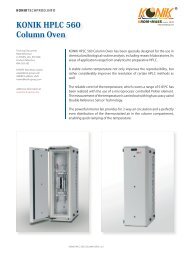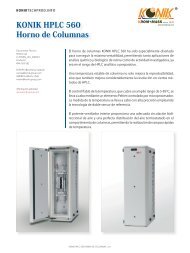Create successful ePaper yourself
Turn your PDF publications into a flip-book with our unique Google optimized e-Paper software.
GC CAPILLARY & PACKED COLUMNS<br />
Step 4. Quality Control<br />
Select proven quality<br />
When you buy a KONIK capillary column you receive a product designed<br />
and manufactured with the aim to help you solve your analytical problems<br />
and which meets all of our quality criteria.<br />
At the same time you obtain from our Technical Department at KONIK the<br />
assurance that we will be at your side to help you with all the problems and<br />
concerns experience in the lab.<br />
Each column is individually tested and the accompanying test data is the<br />
proof that the column meets our quality specications and thus we expect it<br />
to meet your demands. Each one of the columns obtained by this process is<br />
rigorously controlled by means of a strict Quality Control Test (Fig. 5 and 6),<br />
which ensures that you will receive a guaranteed quality product.<br />
Stationary Phase<br />
The selection of the ideal column for a given analysis may look like a<br />
complex problem since we need to be right on the selection of the polarity<br />
of the stationary phase as well as column length, internal diameter and<br />
lm thickness.<br />
The polarity of the stationary phase is chosen depending on the kind of<br />
compounds you wish to separate. Non polar phases, such as KAP-1 and KAP-5,<br />
separate compounds by their boiling points. Intermediate polarity phases<br />
such as KAP-WAX, KAP-1701, combine retention by boiling point with the<br />
more selective interaction through hydrogen bridges or dipolar moments,<br />
etc., and thus provide a higher selectivity. The principal mechanisms of polar<br />
phases such as KAP-CN100 (Cyanosilicone with 100% of cyano propyl groups)<br />
lie in the dipole-dipole interactions between the functional groups of the<br />
stationary phase and those from the substances to be separated. These type<br />
of phases retain polar compounds more than non polar ones.<br />
In general, non polar phases are more thermally stable than the polar phases.<br />
In other words, the higher the column polarity, the lower its thermal stability.<br />
Most of the KONIK columns are cross-linked, which results in high thermal<br />
stability. The cross-linking in a stationary phase produces slight changes<br />
in the physicochemical characteristics of the phase as well as in its polarity<br />
relative to the uncross-linked phase. Thus KONIK also offers in its catalog<br />
columns with non bonded phases that show the selectivity of the original<br />
phase (for instance KAP-SE30, KAP-SE54, KAP-20M, etc).<br />
DTA Curve of KAP-5 polymer<br />
Column: KAP-5 60m x 0.25mm ID x 0.25µm.<br />
Carrier gas: He, 25 psi.<br />
Oven:110ºC (Isothermal).<br />
Injection: 1µl, split. (1:100:250ºC)<br />
Concentration: Aprox. 5ng of each compound on column<br />
Detector: FID, 250ºC<br />
Peak Name<br />
1 - 2-Octanone<br />
2 - C-10<br />
3 - 1-Octanol<br />
4 - C-11<br />
5 - 2,6-Dimethylphenol<br />
6 - 2,6-Dimethylphenol<br />
7 - C-12<br />
8 - C-13<br />
QUALITY CONTROL TEST<br />
Length<br />
The efficiency of a chromatographic column (number of theoretical plates<br />
per meter) is a function of its length. The standard length used for most of the<br />
separations is 25-30 meters. With this length one can obtain a high efficiency<br />
with relative short times of analysis. Columns of 15m are used for rapid control<br />
analyses, reaction monitoring, etc. as well as for the chromatography of high<br />
molecular weight substances while columns of 50-60 m, 100 m or 150 m are<br />
used for very complex samples.<br />
KONIK exclusively has a 150 m column for detail analyses of petroleum and<br />
essential oil hydrocarbons. As a general rule, we can say that in a constant<br />
temperature chromatographic analysis, the number of theoretical plates and<br />
analysis time are directly proportional to the column length while resolution<br />
is directly proportional to the square root of the theoretical plates. Thus, we<br />
need to take into account that when we double column length, its resolution<br />
only increases by 40% whereas analysis time doubles.<br />
Column: KAP-5 30m x 0.25mm ID x 0.25µm.<br />
Carrier gas: He, 12 psi.<br />
Injection: 1µl, split. (1:100), 260ºC<br />
Detector: FID, 280ºC<br />
1<br />
2<br />
3<br />
4 5<br />
6<br />
8<br />
8<br />
Peak Name<br />
1 - 2,3-Butanediol<br />
2 - C-10<br />
3 - 1-Octanol<br />
4 - 2,6-Dimethylphenol<br />
5 - C-11<br />
6 - Nonanal<br />
7 - 2-Ethylexanoic acid<br />
8 - 2,6-Dimethylanine<br />
9 - E-10<br />
10 - Dicyclohexylamine<br />
11 - E-11<br />
12 - E-12<br />
10<br />
11 12<br />
7<br />
GROB test<br />
www.<strong>konik</strong>-group.com Cap. 1: 3












